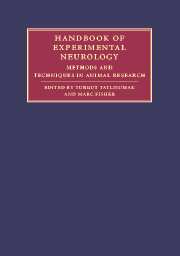Book contents
- Frontmatter
- Contents
- List of contributors
- Part I Principles and general methods
- Part II Experimental models of major neurological diseases
- 18 Focal brain ischemia models in rodents
- 19 Rodent models of global cerebral ischemia
- 20 Rodent models of hemorrhagic stroke
- 21 In vivo models of traumatic brain injury
- 22 Experimental models for the study of CNS tumors
- 23 Experimental models for demyelinating diseases
- 24 Animal models of Parkinson's disease
- 25 Animal models of epilepsy
- 26 Experimental models of hydrocephalus
- 27 Rodent models of experimental bacterial infections in the CNS
- 28 Experimental models of motor neuron disease/amyotrophic lateral sclerosis
- 29 Animal models for sleep disorders
- 30 Experimental models of muscle diseases
- Index
- References
22 - Experimental models for the study of CNS tumors
Published online by Cambridge University Press: 04 November 2009
- Frontmatter
- Contents
- List of contributors
- Part I Principles and general methods
- Part II Experimental models of major neurological diseases
- 18 Focal brain ischemia models in rodents
- 19 Rodent models of global cerebral ischemia
- 20 Rodent models of hemorrhagic stroke
- 21 In vivo models of traumatic brain injury
- 22 Experimental models for the study of CNS tumors
- 23 Experimental models for demyelinating diseases
- 24 Animal models of Parkinson's disease
- 25 Animal models of epilepsy
- 26 Experimental models of hydrocephalus
- 27 Rodent models of experimental bacterial infections in the CNS
- 28 Experimental models of motor neuron disease/amyotrophic lateral sclerosis
- 29 Animal models for sleep disorders
- 30 Experimental models of muscle diseases
- Index
- References
Summary
Introduction
Despite several decades of intensive study, the treatment of brain tumors, whether they have arisen primarily within the central nervous system (CNS) or spread there from elsewhere, represents a formidable challenge for the clinician. Several reasons underlie the difficulties in brain tumor treatment including delivering enough therapy through a blood–brain barrier (BBB), circumventing the relative immunosuppression that occurs both as a result of the brain tumor and due to its development in a relatively immunologically protected area, and the need to preserve the normal surrounding CNS. Such obstacles underscore the importance of accurate preclinical models both to understand the processes by which tumors develop and are sustained as well as to test the effectiveness of various treatments.
While in vitro systems are frequently used to assess both biology and treatment of tumors, the importance of the tumor–normal tissue relationships can only be addressed with in vivo models. Several years ago, Peterson et al. proposed criteria by which to judge the validity of such a model, including: (1) the growth rate of the tumor and its malignancy characteristics should be predictable and reproducible; (2) the species used should be small and inexpensively maintained so that large numbers may be evaluated; (3) the time to tumor induction should be relatively short and the survival time after induction should be standardized; (4) the tumor should have the same characteristics as the clinical tumor in terms of intraparenchymal growth, invasiveness, angiogenesis; (5) tumors should be maintainable in culture and should be safe for laboratory personnel; and (6) therapeutic responsiveness must imitate that of the clinical tumor being tested.
Information
- Type
- Chapter
- Information
- Handbook of Experimental NeurologyMethods and Techniques in Animal Research, pp. 375 - 392Publisher: Cambridge University PressPrint publication year: 2006
